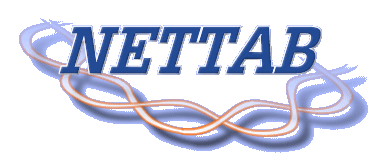
|
Workflows management:
new abilities for the biological information overflow 5-7 October, 2005, Second University of Naples, Naples, Italy |
The NETTAB 2005 workshop was focused on:
"Workflows management: new abilities for the biological information
overflow".
Follow the links in the right menu for accessing desired information.
Workshop rationale
It is well known that bioinformatics has to cope with one of the hugest amount of information in all knowledge domains. This does not only include biological sequences and structures, but also and increasingly microarray data, metabolic pathways, interaction maps, gene networks. Moreover, there is an exponential increase of this information (e.g., DNA sequences increased more than 10% during last three months), so that it won't be locally manageable soon.
This huge amount of data is also largely distributed over the network, has heterogeneous data structures and information systems and, often, even a different semantics. The same heterogeneicity applies to the many available softwares.
Moreover, the biomedical research domain is one of the fastest evoluting research areas. New hypothesis and knowledges are accumulated daily, often leading to new data and elaboration needs. User needs are often very peculiar, deeply different from one application domain to another. In this frame, the development of general purpose applications is difficult, both for the different users' needs and the quickly accumulating knowledges, and limited to essential tools.
Biological information is made available to researchers through web sites. Biologists connect to many sites and switch among them to submit and retrieve preliminar and intermediate data. Final achievements are often the result of a manual integration activity. The huge amount of information makes its access un-exhaustive and inefficient and requires the development of complex searching and retrieval softwares. They can be developed to perform this integration activity, provided that they are taught the semantics of the information, how to link data and how to pipe retrieval and analysis steps.
According to the Workflow Management Coalition, a workflow is "a computerized
facilitation or automation of a business process, in whole or part".
Its main goal is the implemention of data analysis processes in standardized
environments.
Its main advantages relates to:
- effectiveness: being an automatic procedure, it frees the bioscientist from repetitive interactions with the web and it supports good practice,
- reproducibility: analysis can be replicated over time,
- reusability: intermediate results can be reused,
- traceability: the workflow is carried out in a transparent analysis environment.
Advantages of changing current biological information management from a human-oriented to a machine-oriented approach are therefore clear. Machine orientation is quickly improving, both as to technologies and tools and as to its diffusion in the biomedical domain. Many Web Services have been implemented, even by som eof the most important network service Institute, such as EBI and NCBI. Technologies related to registries of biological web services and related implementation are also emerging, e.g. bioMOBY.
It is therefore not surprising that implementation of workflows management software already started. In recent years, we had Biopipe, an add-on to bioperl for pipelines management, GPipe, an extension of the Pise interface, and, especially, Taverna, the most well known workflow management tool that is being developed within MyGrid project. And many others are coming.
You can have a look at the presentation of the NETTAB 2005 workshop given by Paolo Romano at the end of the NETTAB 2004 workshop in Camerino.
Scientific Programme
Overview -
Invited Speakers
Programme
Abstracts
Presentations
Call for Papers
Overview
Scope -
Topics
Type of contributions
Deadlines
Registration Form
Overview
Subscribe mailing list
Register to the Workshop
Useful Info
Contacts -
How to reach
Deadlines -
Hotels
Fees -
External links
Workshop Organization
Scientific Committee
Organizing Committee
Institutes & Societies
Sponsors